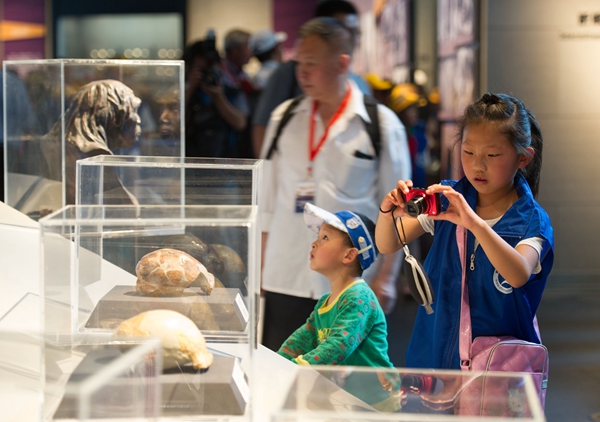 |
Visitors look at relics at a museum of the Zhoukoudian Peking Man Site. This year marks the 90th anniversary of the discovery of the first Peking Man skull.[Photo/Xinhua] |
Paleontologists gathered in Beijing earlier this month to mark the 90th anniversary of the discovery of the first skull of Peking Man, the Homo erectus who lived about 700,000 years ago in what are today the suburbs of China's capital.
Nearly 200 Chinese and foreign scholars attended the international symposium on paleoanthropology to share their latest discoveries and push forward research on human origins and evolution.
The first complete skull of Peking Man was found by Chinese archaeologist Pei Wenzhong in December 1929 at Location 1, or the Peking Man Site-one of the four sites in Zhoukoudian in Beijing's Fangshan district where ancient human fossils have been found.
The collection of fossils, including six skulls, unearthed at Location 1 in the 1920s and '30s, was found to belong to over 40 individuals.
Over the past 90 years, more fossils of ancient humans dating back to the Pleistocene era (about 2.9 million to 11,700 years ago) have been found at over 70 sites across China, Wu Xiujie, a researcher with the Institute of Vertebrate Paleontology and Paleoanthropology of the Chinese Academy of Sciences, said at the symposium.
The latest studies on Zhoukoudian sites show that the H. erectus in Far Eastern and African contexts can be grouped as the same species due to their similar characteristics, Wu says.
She says different H. erectus branches with complex physical characteristics and large internal variation may have existed in the late Middle Pleistocene in China.
"The discovery of the Peking Man fossils indicated the existence of H. erectus, which was a giant leap in the research of human evolution at that time," says Gao Xing, a researcher of the IVPP.
Gao and other scholars have kept searching for clues about the missing fossils at home and abroad, but found none.
"As long as there is any hope, we will spare no effort to look for them," he says.
"Zhoukoudian is not only a relic for visitors to remember but also a research base full of academic vitality."
Gao adds that more excavations and studies will be done at the site.
UNESCO listed it as a World Heritage Site in 1987.
"Zhoukoudian is more than a place where we found human fossils," says John Olsen from the University of Arizona. He adds that the legacy is of great significance for its "interdisciplinary perspective, long-term international collaboration and integrated paleoanthropological orientation".
The participants also celebrated the 90th anniversary of the founding of the IVPP.
"I think the IVPP is really now one of the most important institutions in the world in paleontology, thanks to the efforts made by the remarkable scientists," says Philippe Janvier, a French paleontologist.
Jingmai O'Conner, a foreign researcher who has worked in the IVPP for 10 years, says, "Nowhere else in the world is there such a large number of expert paleontologists under one roof-nor such incredible collections or the abundant resources to study them."
The IVPP will continue to cultivate talent in the fields of paleontology, paleoanthropology, archaeology, stratigraphy and paleoenvironmental studies. It'll establish a world-class scientific platform for studying biological evolution and the origins of human beings, says Deng Tao, director of the IVPP.
Some 90 specimens from the IVPP have been on display at an exhibition since Nov 30 to celebrate the two anniversaries.